| Article ID | Journal | Published Year | Pages | File Type |
|---|---|---|---|---|
| 9645022 | Neurobiology of Aging | 2005 | 16 Pages |
Abstract
We used high-resolution MRI to investigate gray and white matter aging in the major lobes of the cerebrum (frontal, parietal, temporal, occipital) and the major sectors of the temporal lobe (temporal pole, superior temporal gyrus, infero-temporal region, parahippocampal gyrus, amygdala, hippocampus). Subjects included 87 adults between the ages of 22 and 88 years. Regions of interest were hand-traced on contiguous 1.5Â mm coronal slices. For the cerebrum in general, gray matter decreased linearly with age, resulting in a decline of about 9.1-9.8% between the ages of 30 and 70 years, and a decline of 11.3-12.3% by the age of 80. In contrast, white matter volume increased until the mid-50s, after which it declined at an accelerated rate. At 70 years, white matter volume was only 5.6-6.4% less than at 30 years, but by age 80, a cubic regression model predicted that the decrease would be 21.6-25.0%. Multivariate analyses indicate that the frontal gray matter was most strongly associated with age, while occipital gray and white matter were least associated. Reduction in volume in the hippocampus was best modeled by a cubic regression model rather than a linear model. No sex differences in aging were found for any regions of interest.
Keywords
Related Topics
Life Sciences
Biochemistry, Genetics and Molecular Biology
Ageing
Authors
John S. Allen, Joel Bruss, C. Kice Brown, Hanna Damasio,
